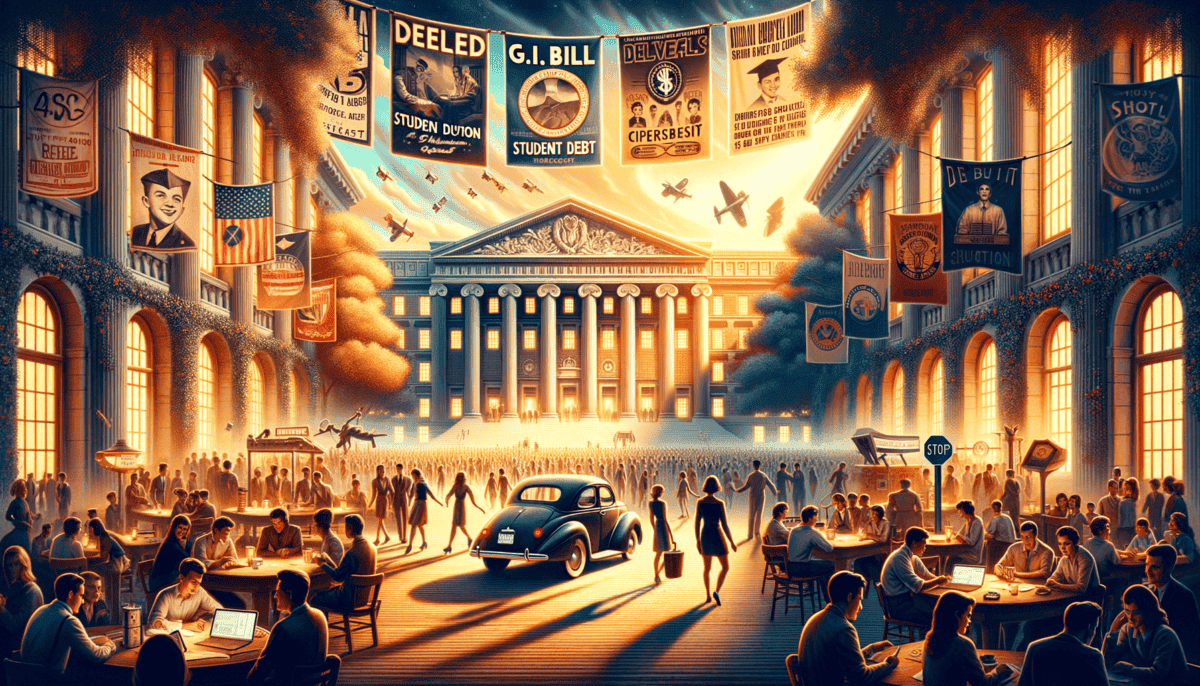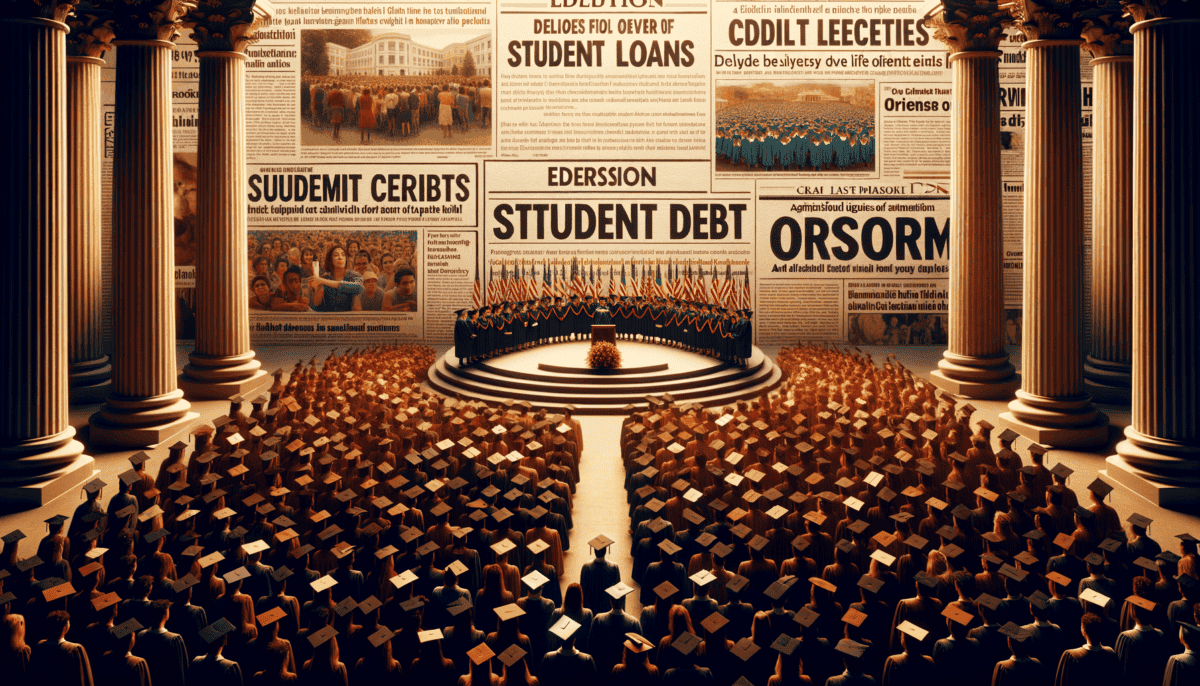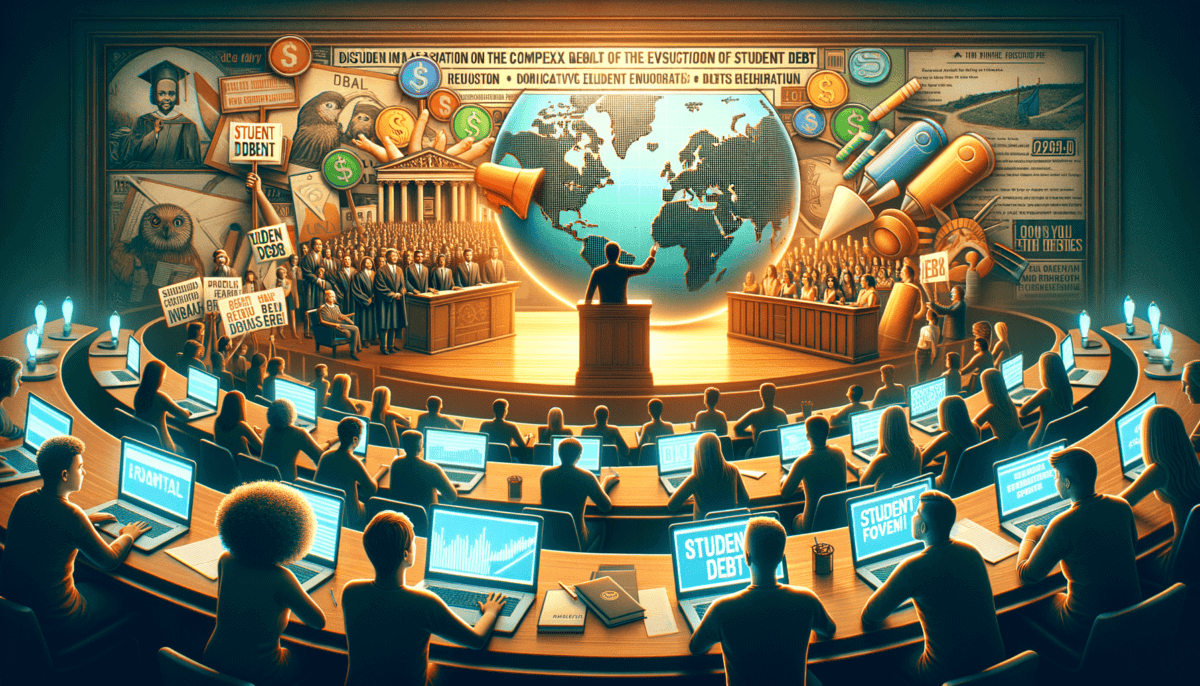The Seeds of Borrowing
Sarah sat at her grandmother's kitchen table, flipping through a dusty photo album. The black and white pictures showed young people in caps and gowns, smiling proudly.
"Grandma, was college always so expensive?" Sarah asked, looking up from a photograph dated 1920.
Her grandmother, Eleanor, settled into the chair beside her. "Oh no, dear. But it wasn't easy to go to college back then either. Let me tell you about how it all started."
Eleanor pointed to the old photo. "In those days, only rich families could send their children to college. Most people started working right after high school – if they even finished high school!"
"But what if someone really wanted to learn?" Sarah asked, her eyes wide with curiosity.
"Well," Eleanor smiled, "that's when the first student loans began. Harvard University started helping students in 1840. They created a special fund that students could borrow from."
Sarah looked confused. "Like getting money from a bank?"
"Sort of," Eleanor explained. "But banks didn't want to lend money to students back then. They thought it was too risky. So schools had to find other ways to help."
A New Kind of Help
The story continued as Eleanor showed Sarah more photos. She pointed to a picture of a serious-looking man named Benjamin Ide Wheeler.
"This man helped create one of the first big student loan programs in 1909. He wanted to help bright students who couldn't afford college."
Sarah leaned in closer. "Did it work?"
"It did help some people," Eleanor nodded. "But it was just the beginning. More schools started creating similar programs. They called them 'student aid societies.'"
“Education is the key to opportunity, but back then, that key was locked away from most people.” – Eleanor
Changes Begin
The afternoon sun streamed through the kitchen window as Eleanor showed Sarah more pictures. "By 1920, things started to change. More people wanted to go to college. They knew education could help them get better jobs."
"Like how Mom says I need to study hard?" Sarah asked.
Eleanor laughed. "Exactly! But imagine if there were no loans at all. Many smart kids couldn't go to college just because their families didn't have enough money."
Sarah looked thoughtful. "That doesn't seem fair."
"You're right," Eleanor agreed. "That's why people started working to change things. They believed everyone deserved a chance to learn."
Early Solutions
"Some schools found creative ways to help," Eleanor continued. "They let students work on campus to pay for their classes. Others created payment plans so families could pay a little bit at a time."
Sarah picked up another photo showing a group of students working in a library. "Like these people?"
"Yes! Those students were probably working to pay for their education. It wasn't easy, but it gave them a chance they wouldn't have had before."
• Working while studying
• School payment plans
• Help from their college
• Support from wealthy donors
• Family savings
"The story of student loans is like a tiny seed that grew into a big tree," Eleanor explained, closing the photo album. "It started small, with just a few schools trying to help their students. But it grew into something much bigger."
Sarah hugged her grandmother. "Thanks for telling me the story, Grandma. Can you tell me what happened next?"
Eleanor smiled. "That's a story for another day. But I'll give you a hint – it involves something called the G.I. Bill, which changed everything!"
The sun was setting outside, casting long shadows across the kitchen floor. Sarah knew there was more to learn about how college became what it is today. But for now, she was happy just understanding how it all began.
Dreams and Soldiers: The G.I. Bill Revolution
Sarah bounced into her grandmother’s kitchen the next day, eager to hear more. “Grandma, you promised to tell me about the G.I. Bill!” ️
Eleanor smiled, pulling out a worn photograph of a young man in uniform. “This was your great-grandfather Jack, coming home from World War II. He was one of millions of soldiers who got to go to college because of the G.I. Bill.”
“Before the war,” Eleanor explained, “most people still couldn’t go to college. But when the soldiers came home in 1944, everything changed.”
Sarah looked puzzled. “Why did they help the soldiers go to college?”
A New Beginning
“Well,” Eleanor began, “the country wanted to thank the soldiers for their service. They also wanted to help them start new lives. The G.I. Bill paid for their college, books, and even gave them money to live on!”
“Your great-grandfather always said the G.I. Bill changed his life. He went from being a farm boy to becoming an engineer!”
Sarah’s eyes widened. “Did lots of soldiers go to college?”
“Oh my, yes! Almost half of all college students were veterans in 1947. The classrooms were packed!”
Big Changes
Eleanor pulled out more photos showing crowded college campuses. “Colleges had to build new buildings. They needed more teachers. Everything got bigger!”
“But the most important change,” Eleanor continued, “was how people thought about college. Suddenly, everyone could dream of going – not just rich people.”
The Middle Class Goes to College
“After the soldiers showed how well college could work for regular people, everyone wanted to go,” Eleanor explained. “The government started helping more students with loans and grants.”
“Like my piggy bank?” Sarah asked.
Eleanor laughed. “Sort of! But instead of saving money, the government would lend it to students. They could pay it back after they finished school and got jobs.”
| Before G.I. Bill | After G.I. Bill |
|---|---|
| Few people went to college | Many people went to college |
| Mostly rich families | All kinds of families |
| Small colleges | Big universities |
New Dreams Growing
“Parents started saving money for their kids to go to college,” Eleanor said. “They believed education would help their children have better lives.”
“The government created special programs to help students,” she continued. “In 1958, they made something called the National Defense Student Loan Program. It helped even more people go to college.”
• Free college for veterans
• More jobs needed college degrees
• Government helped with costs
• Families believed in education
• Better jobs after graduation
Sarah looked at the old photos again. “So the G.I. Bill made college normal?”
“Exactly!” Eleanor beamed. “It opened doors for so many people. But it also started something new – more and more people borrowing money for school.”
The kitchen clock chimed, and Sarah realized it was getting late. “What happened to all those loans, Grandma?”
Eleanor patted her hand. “That’s when things started getting complicated. The 1970s brought big changes – and some big problems too.”
Money Troubles: When College Costs Soared
“What happened in the 1970s, Grandma?” Sarah asked the next morning, munching on her breakfast toast.
Eleanor sighed, pulling out some old college brochures. “That’s when college started getting very expensive, sweetie. Much more than before.”
The Big Jump
“Look at this,” Eleanor said, showing Sarah two price tags. “In 1970, one year of college cost about $1,500. By 1980, it was over $3,000!”
Sarah’s eyes got big. “That’s a lot more!”
“Yes, and people needed help paying for it. That’s when a new helper called Sallie Mae came along.”
“Sallie Mae wasn’t a real person – it was a big company that gave loans to students. They wanted to make it easier for people to borrow money for school.”
Private Money Steps In
“Before this,” Eleanor explained, “most student loans came from the government. But now banks and companies like Sallie Mae started giving loans too.”
| Government Loans | Private Loans |
|---|---|
| Lower costs to pay back | Higher costs to pay back |
| More helpful rules | Stricter rules |
Sarah looked confused. “But why did college cost so much more?”
The Price Problem
• Schools built new buildings
• They hired more teachers
• They added more programs
• They bought new equipment
• Everything cost more to run
“It was like a snowball getting bigger and bigger,” Eleanor said. “Schools spent more money, so they charged more money. When they charged more, students needed to borrow more.” ❄️
Warning Signs
“Some smart people started to worry,” Eleanor continued. “They saw that students were borrowing more money than they could pay back.”
“Like when I spend all my allowance too fast?” Sarah asked.
“Sort of, but much bigger! People were borrowing thousands of dollars. When they finished school, they had big bills to pay every month.”
“Many people started having trouble paying back their loans. It was the beginning of what we now call the student debt crisis.”
Dreams and Worries
“Everyone still wanted to go to college,” Eleanor explained. “They knew it could help them get better jobs. But now they had to worry about paying back big loans.”
Sarah frowned. “That doesn’t sound fair.”
“You’re right,” Eleanor nodded. “And it was just the start. Things got even harder in the years that came next.”
The morning sun streamed through the kitchen window as Sarah thought about all she had learned. “What happened to make things harder, Grandma?”
Eleanor glanced at the clock. “That’s a story for tomorrow – about how these money problems grew into something much bigger in our time.”
When Student Debt Got Really Big
Sarah woke up early, excited to hear more of Grandma Eleanor’s stories. “Tell me what happened next with college money!”
The Big Wave
“Well, sweetie,” Eleanor began, “remember how college was getting more expensive? In the 2000s, it got much, much bigger – like a huge wave.”
“What made it get so big?” Sarah asked, her eyes wide.
The Money Storm
“In 2008, something bad happened. It was called the Great Recession. Many people lost their jobs and homes.”
“When times got hard, more people went back to school. They hoped better education would help them find jobs. But that meant more people needed to borrow money.”
Meet Maria’s Story
“Let me tell you about my friend Maria,” Eleanor said. “She wanted to be a teacher.”
“Maria borrowed $50,000 for school. She thought she could pay it back with her teaching job. But when she finished school, her job didn’t pay enough.”
• Teaching salary: $2,500
• Student loan payment: $500
• Rent: $1,200
• Food and bills: $800
“Poor Maria!” Sarah exclaimed. “That doesn’t leave much money for fun things!”
People Start Speaking Up
“Many people were like Maria. They started telling their stories and asking for help.”
“They made groups and went to Washington D.C. They told leaders that student debt was hurting too many people.”
“We need college to cost less!”
“Help us pay back our loans!”
“Make education fair for everyone!”
Looking for Answers
“Did the leaders help?” Sarah asked hopefully.
“Some tried. They made plans to:”
- Make loan payments smaller
- Forgive some student debt
- Help people who work as teachers or nurses
- Make some community colleges free
New Ways to Learn
“People also found different ways to learn,” Eleanor explained. “Some took classes on computers at home. Others went to special training schools.”
“That sounds smart!” Sarah nodded.
“Yes, but the big problem wasn’t fixed. College still costs too much, and many people still need loans to pay for it.”
The Fight Goes On
“More and more people joined together to fight for change. They used social media to share their stories. They had big meetings to talk about solutions.” ✊
“Young people like you started asking questions too. They wanted to know why college couldn’t be cheaper, like it is in other countries.”
Sarah leaned forward. “What do other countries do differently?”
Eleanor smiled. “That’s a very good question. Some places have found better ways to help students. Would you like to hear about them?”
Sarah nodded eagerly, ready to learn how other kids around the world go to college without such big money worries.
How Other Countries Handle College Money
Sarah bounced on her chair. “Tell me about school in other places!” she said to Grandma Eleanor.
A Trip Around the World
“Let’s go on a pretend trip,” Eleanor smiled. “First stop: Germany!”
“Free?” Sarah’s eyes got big. “How do they do that?”
“The whole country helps pay for it with taxes. They think education is super important for everyone!”
Next Stop: Norway
“In Norway, it’s like a winter wonderland,” Eleanor said. “And guess what? College is free there too!” ❄️
“Norwegian students can focus on learning instead of worrying about money. They even get help paying for food and a place to live!”
Jumping to Japan
“In Japan, they do things differently,” Eleanor explained. “College costs money, but not as much as here.”
“Many Japanese families save money for college since their kids are tiny babies. The whole family helps!”
• Special college savings accounts
• Birthday money goes to college fund
• Grandparents help save too
• Some companies help workers save for their kids
Australia’s Smart Plan
“Australia has a really clever way,” Eleanor continued. “Students don’t pay until they get a good job!”
“How does that work?” Sarah asked.
“They wait until you make enough money. Then you pay a little bit each month. If you lose your job, you can stop paying until you find a new one.”
Learning from Others
“These countries show us there are many ways to help students,” Eleanor said. “Some use computers to make learning cheaper.”
“Some schools let students learn at home part of the time. Others have special short classes to learn job skills quickly.”
New Ideas Coming
“People are trying these ideas in America too!” Eleanor said excitedly. “Some schools are:”
- Making online classes better
- Teaching job skills faster
- Working with companies to train workers
- Finding ways to make books cheaper
Working Together
“Countries are sharing their good ideas,” Eleanor explained. “They’re using computers and the internet to help more people learn.”
“That sounds great!” Sarah clapped. “Maybe we can use their ideas here?”
“That’s right! Many people are working hard to make college better and cheaper for everyone.”
Hope for Change
“The whole world is thinking about how to make school better,” Eleanor said. “More people are saying education should be for everyone, not just people with lots of money.”
Sarah thought for a moment. “What’s going to happen next, Grandma?”
Eleanor smiled warmly. “Well, that’s where things get really interesting. Want to hear about the new ideas people are working on?”
New Ideas for Better Schools
Sarah leaned forward eagerly. “Yes, please tell me about the new ideas!”
Smart Solutions Coming Soon
“People are working on amazing plans,” Eleanor said with a bright smile. “Let me show you some cool things that might happen!”
Learning Anywhere, Anytime
“Remember how we use tablets to play games?” Eleanor asked. “Now schools are using them to teach!”
“Students can learn from home, on the bus, or even in the park. This makes school cheaper and easier to fit into busy lives.”
Short and Sweet Learning
“Instead of going to school for four whole years,” Eleanor explained, “some people are taking quick classes to learn just what they need.” ⚡
“Like cooking school?” Sarah asked.
“Exactly! Or learning to fix computers, or build houses. These shorter classes cost less money!”
Companies Help Students
“Some companies are doing something really nice,” Eleanor smiled. “They’re paying for workers to learn new things!”
• Pay for classes
• Give time off to study
• Teach job skills at work
• Help pay back student loans
Working Together for Change
“Lots of people are speaking up,” Eleanor said. “They’re asking for better ways to pay for school.”
“Teachers, parents, and students are working together to make things better. They’re:
- Writing letters to leaders
- Coming up with new ideas
- Sharing stories about school costs
- Finding ways to help each other
Hope for Tomorrow
“The best part is,” Eleanor beamed, “more people understand that everyone deserves a chance to learn.”
“When we all work together, we can make great things happen. The future of school looks bright!”
Sarah’s Big Dream
Sarah jumped up and hugged her grandma. “When I grow up, I want to help make school better for everyone!”
“That’s wonderful, sweetheart,” Eleanor said proudly. “Every big change starts with people who care.” ❤️
A New Chapter Begins
“Remember,” Eleanor said softly, “learning is one of the most precious gifts we can give each other. And together, we’re making sure everyone can have that gift.”
Sarah looked out the window at the setting sun. She knew that somewhere out there, people were working hard to make her future, and everyone’s future, better and brighter.






